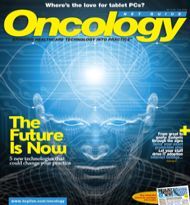Publication
Article
ONCNG Oncology
Oncology Outlook: End-users Should Ultimately Drive IT Adoption
Author(s):
In preparing an organization for IT transformation, the most important step is organizing and managing people.
In preparing an organization for IT transformation, the most important step is organizing and managing people. Even in an IT-enabled environment, it is still the people who get things done, or who are often the fi rst indicators of something being amiss.
The biggest reason that IT projects fail is lack of buy-in from staff . Many times, embracing IT transformation also means embracing a culture of change. It is a perpetual path that requires new ways of thinking and relating. The fundamental human communications and interconnections of the organization are altered. How will interactions with patients be aff ected? How will things be different if many direct personal communications are transformed into sending an e-mail or instant message embedded in the workflow of an EMR tool? If the organization does not accept the changes in tools, it doesn’t matter how carefully they were selected.
It is important to have a clearly defined management team that will drive the IT initiative with careful prospective planning. Apart from the obvious process of hardware and software selection, this group is key to helping set expectations and managing and supporting staff through the changes.
The composition of the IT management team needs to be representative not only of IT technical experts, but also various areas of the organization that will be impacted by the changes; most importantly, the clinical areas need to be represented. The ideal clinical personnel are well respected by their peers and also have some understanding or interest in IT. The most successful IT transformations are frequently led by a physician champion who can bring other clinicians along. Mid-level providers and nursing staff in a busy clinic are often aff ected most, and it helps to involve them early in the planning process. Many times, it is out of these personnel that clinical super users are created.
These super users are not only an accessible resource for other staff , but they can also provide insight into why the effort is so important to moving forward. Lab, pharmacy, operations, and revenue cycle managers should be considered. We not only want to provide great care and service, but also get paid for the work we do in the environment of perpetually declining reimbursements. Not all of these members need to be present at every meeting, but input from all the key areas is important.
Potential pitfalls of planned changes need to be identifi ed as early as possible. It is diffi cult to get an IT project back on track if there are one or two major disasters, and the organization loses enthusiasm and faith that the transition eff orts will lead to a better set of processes and a more effective organization.
Most organizations carve out time for IT planning as a part of the workweek. Because it is diffi cult to move these initiatives forward with a group of volunteers working after hours or spending uncompensated time away from other activities that generate income, compensating the team for their time is important and is a way of communicating the commitment to transforming through technology.
The IT planning team will develop its own agenda for adoption. However, some key areas include:
- What is the vision?
- How will it affect patient care?
- How will it affect the staff ?
- How will my area be affected?
- How will staff roles change?
- What opportunities will be created?
- Will things work well together?
- What will get easier?
- What will get more difficult?
- If things get more diffi cult why do we need to put in the effort to accomplish them?
- Are we HIPAA compliant?
- Are the systems interoperable?
- How can the organization best prepare for these changes?
The IT management group will take the executive drivers and direction and expand them. Once the people are organized and their needs addressed, the remaining principles and processes will guide the crystallization of the IT architecture. Th is is the point at which true IT architecture planning is ready to begin!
Dr. Sharma is CEO of Texas Cancer Associates, a midsize oncology practice based in Dallas/Fort Worth, TX. He is also CEO of HealthIT, an Internet services company that supports the patient/ provider network with technology solutions, and founder of NextGen Oncology, which works to provide next-generation solutions for the diagnosis, management, and treatment of cancer. E-mail Dr. Sharma at JSharma@MyCancerCenter.com.
